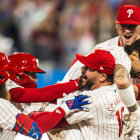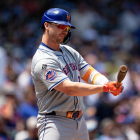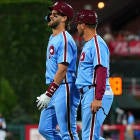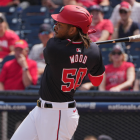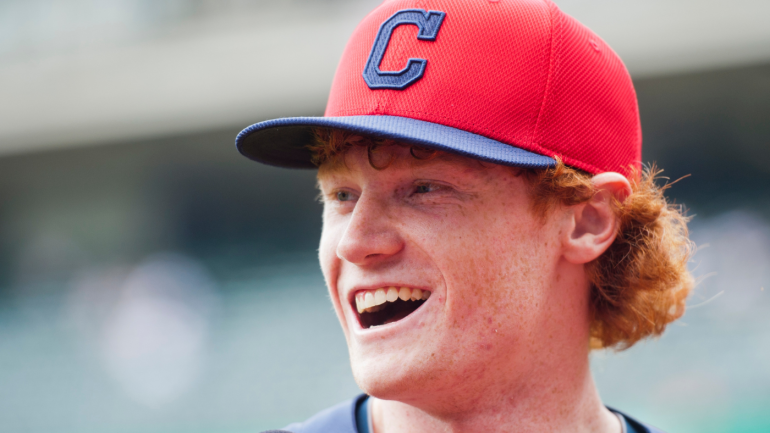
Major League Baseball's amateur draft will kick off on Sunday, July 14. As is custom, the draft will coincide with the beginning of the league's All-Star Game festivities (hosted by the Rangers at Globe Life Field in Arlington, Texas). The Cleveland Guardians, by virtue of winning last winter's lottery despite trifling odds, will make the No. 1 selection for the first time in franchise history.
The Guardians may be new to picking first overall, but they're no strangers to selecting near the top of the draft. Indeed, Cleveland has chosen second on five occasions, and has five other top-five picks (albeit none since 2013). For some perspective on how the Guardians have fared when they've selected in a premium spot, let's revisit each of those 10 top-five picks. (Do note that the players are presented in chronological order by their draft year.)
1970: RHP Steve Dunning, No. 2 overall
Get used to reading this: the San Diego Padres drafted ahead of the Guardians, taking prep catcher Mike Ivie. In turn, the Guardians chose Dunning, the only collegiate to come off the board in the top five. He reached the majors that year, and would go on to make 136 career appearances. The Guardians traded Dunning in 1973 in exchange for veteran righty Dick Bosman and outfielder Ted Ford, who would see his big-league career end following 11 more games played. This wasn't a particularly rich round, with just two players compiling more than 10 Wins Above Replacement: outfielder Dan Ford (No. 18) and catcher Darrell Porter (No. 4).
1972: SS Rick Manning, No. 2 overall
The San Diego Padres used the first pick (see?) on third baseman Dave Roberts (not that one), clearing the way for the Guardians to take Manning. He'd reach the majors as a 20-year-old, and he would end tallying more than 11 Wins Above Replacement during a nine-year stint with the team. For those wondering, that ranked as the fourth most among first-round picks that year, behind Dick Ruthven (who did not sign), Scott McGregor, and Chet Lemon. Manning can be heard nightly as part of the Guardians' television commentary crew.
1973: INF Glenn Tufts, No. 5 overall
Tufts, a prep shortstop from Massachusetts, would have his playing career end after his age-22 season when it became evident he couldn't hit Double-A pitching. (He would, nevertheless, remain around the game as a coach and a scout.) You can understand if Guardians fans view this draft with regret -- not because of who was selected after Tufts (though some solid players were), but because of who was drafted before him: future Hall of Famers Robin Yount (No. 3) and Dave Winfield (No. 4). It was a bad year to pick fifth.
1974: RHP Tom Brennan, No. 4 overall
Brennan, a right-hander from Lewis University, didn't make his big-league debut until he was nearly 29 years old. He'd make 64 appearances overall, most of them with the Guardians, and would finish his career with a 91 ERA+. The Atlanta Braves chose Dale Murphy with the next pick, and we think it's fair to write that the Guardians found themselves wanting a do-over often during Murphy's storied career. Some other notable players selected after the Guardians' pick include Willie Wilson, Lance Parrish, Rick Sutcliffe, and Garry Templeton.
1984: SS Cory Snyder, No. 4 overall
Snyder became the highest player ever selected out of BYU in the regular June draft when Cleveland took him No. 4 in 1984. He'd reach the majors in 1986, and would end up appearing across nine seasons overall. That included a freshman showing that saw him finish fourth in Rookie of the Year Award voting. Nevertheless, Guardians fans have probably thought about how things might've been different for their team if they had instead selected Mark McGwire, a first baseman from USC taken 10th overall, or Jay Bell, a prep shortstop chosen No. 8.
1986: LHP Greg Swindell, No. 2 overall
The Pittsburgh Pirates chose first in 1986, selecting infielder Jeff King from Arkansas. The Guardians then chose Swindell, a lefty from Texas who arrived in the majors almost immediately thereafter. Swindell would spend seven years in Cleveland, compiling a 107 ERA+ and making the 1989 All-Star Game. In 1991, the Guardians traded him to the Reds for a package of players: right-handers Jack Armstrong, Scott Scudder, and Joe Turek (who never reached the majors). Swindell would eventually convert to relief, extending his career to include parts of 17 seasons. His 30-plus Wins Above Replacement ranks fourth in that first round. It's hard to do much better than that. Alas, the three players ahead of Swindell in that respect -- Matt Williams, Gary Sheffield, and Kevin Brown -- were selected with the third, fourth, and sixth picks, providing Guardians fans with some reason to play the what-if game after all these years.
1988: SS Mark Lewis, No. 2 overall
The San Diego Padres (we told you) plucked right-hander Andy Benes with the top pick, leaving the Guardians to select Lewis, a local product who attended high school about 30 minutes from Cincinnati. Lewis would reach the majors in 1991, and would appear in parts of 11 big-league seasons as a journeyman reserve without a potent stick. The Guardians traded Lewis to the Reds in 1994 for outfielder Tim Costo. (Costo would never appear in a big-league game with Cleveland.) With the benefit of hindsight, the Guardians should have selected third baseman Robin Ventura. Although he wasn't picked until 10th, he ended up being the most productive player chosen in the first round.
1992: RHP Paul Shuey, No. 2 overall
After the Houston Astros used the top selection on Cal State infielder Phil Nevin, the Guardians grabbed the hard-throwing Shuey from UNC. He moved quickly through their system, jumping from Class-A to the big-league bullpen. Shuey would make 361 career appearances for the Guardians, all in relief, and would compile a 120 ERA+ along the way. Of course, if the Guardians could do it all over again, they'd probably pick Michigan prep shortstop Derek Jeter at No. 2. Jeter instead was selected by the New York Yankees at No. 6. We needn't write more than that.
2010: LHP Drew Pomeranz, No. 5 overall
Pomeranz, an Ole Miss lefty with a quality curveball, became Cleveland's first top-five selection in nearly two decades. His stay with the organization was a short one, as the Guardians shipped him to the Colorado Rockies at the 2011 deadline as part of a trade for Ubaldo Jiménez. Jiménez would largely disappoint with the Guardians, failing to regain the form he had demonstrated when he finished third in Cy Young Award voting in 2010. Pomeranz himself would require some patience. It wasn't until he was with his fourth organization that he made his first (and only) All-Star Game as a starter. He's since authored several other quality seasons as a reliever. Pomeranz was recently released after spending the season with the Dodgers' Triple-A affiliate. He hasn't pitched in MLB since 2021 due to injury.
2013: OF Clint Frazier, No. 5 overall
It's been more than a decade since the last time the Guardians made a top-five selection. They used that pick on Frazier, a Georgia prep outfielder with phenomenal bat speed. Frazier wouldn't make it to the big leagues with the Guardians, however, as he was traded to the New York Yankees at the 2016 deadline as part of a package deal for left-handed reliever Andrew Miller. Whereas Miller became an instrumental part of the Guardians' pennant victory, Frazier never quite entrenched himself at the big-league level. At last check, he had signed with an independent league team after amassing a 100 OPS+ in 280 big-league games. It's fair to write that the Miller trade validated this selection, making it easier for Cleveland fans to accept passing on Aaron Judge, Tim Anderson, and other stars who were selected after the Guardians' pick.












